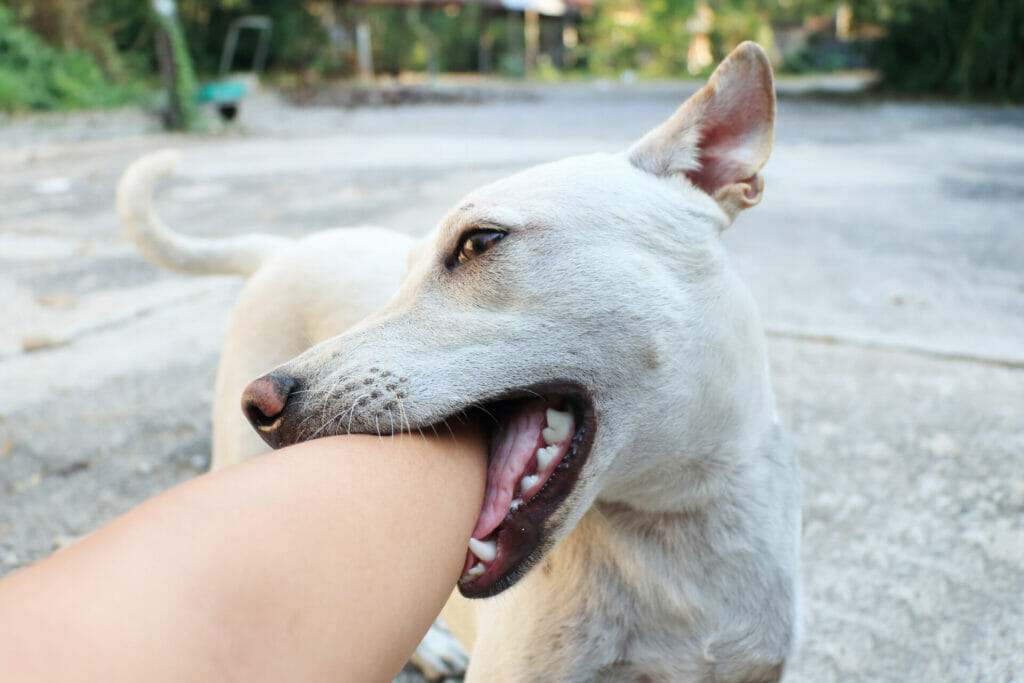When those shark-like teeth emerge from your sweet puppy’s mouth and wreak havoc on your household, it can be a rude awakening. All dogs can bite humans, and something as innocent as an energetic play session or as accidental as stepping on your dog’s tail could result in painful puncture wounds if your dog isn’t aware of the intensity of their bite on human skin. To help avoid this, one of the most essential things in a pup’s development is teaching them to bite inhibition.
What is bite inhibition?
Bite inhibition is the ability of a dog to control the force of their bite. Molly is an excellent example of bite inhibition: Molly is a two-year-old chocolate labrador retriever. As a retriever, one of her favorite things to do is “retrieve” her mom Dani! In her happy moments, she will come up and start “retrieving” Dani’s wrist. She will gently hold Dani’s wrist in her mouth and start wiggling her entire body. Dani finds this behavior super cute only because Molly isn’t applying any pressure on Dani’s wrist and has established good bite inhibition. She can control her bite and not leave a mark or cause any discomfort.
When teaching your puppy bite inhibition, the end goal is for them to have a “soft mouth” during their interactions with you and other dogs. When their teeth hit your skin, they should always be as soft as possible. We don’t want them to clamp down on your skin or apply intense pressure when interacting with you or other pups they are playing with.
How do I teach bite inhibition?
Though certain bite inhibition levels can be genetic, most pups learn bite inhibition environmentally when they are with their littermates. It is essential not to remove a pup from their litter too early because they will lose out on the opportunity to learn from their siblings or mom dog during their most impressionable stage in life. If you can wait, it is best to only take home a pup after eight weeks.
It’s possible to teach an older dog bite inhibition, but please note that the older the dog is, the more likely the pup will fall back to hard biting in times of stress or arousal. Patience is vital when it comes to teaching an old dog new behaviors!

The Don’ts:
Don’t yell at your dog if they accidentally bite you hard in a play session. Quickly remove yourself instead. Your dog won’t understand why you’re yelling at them, which could give them a conflicted relationship to play sessions with you.
Don’t grab or hold your pup’s muzzle down if it bites. This aversive technique could, unfortunately, teach your dog that their only options are not to bite at all or to bite hard out of fear or defense. These dogs “bite out of nowhere” because they’ve been taught not to give warning signals or softer warning bites before the big scary, intense bite. Instead, we want them to learn the alternate option of interacting with us gently with their teeth.
The Dos:
If your puppy’s teeth pierce your skin, you can give your dog a vocalization. You can provide a high-pitched “Ow!” or yelp and then remove yourself from your puppy to indicate in your body language that you don’t like that behavior. Some puppies will accidentally bite when playing tug of war, so in this scenario, you would yell “Ow!”, stop playing with your puppy, and then walk away for several seconds. Walking away teaches your pup that the good thing he wants – you – will be removed if he continues to bite hard. You can then wait 30 seconds before heading back to your pup and trying to play calmly again. As long as he bites softly, continue playing. Any time the bite hurts, say “ouch!” and then leave.
As your dog learns to control their hardest of bites, you can gradually start raising the bar for your bite inhibition training. Using the same methods, you can shape a softer and softer mouth over time. Once your pup isn’t biting hard enough to cause pain, use your “Ow!” technique for moderately hard bites, then medium ones, and eventually for any bites to the skin.

You can also teach your puppy the “gentle” cue. You can hold a treat in your closed fist and offer it to your puppy. When you feel your puppy’s mouth soften, you can open your hand and feed the treat from the palm of your hand. This helps teach the puppy that he gets the treat when his mouth is soft.
Redirection: Play fetch games with your pup to help redirect his mouth to more appropriate toys to play with! If your dog is very drawn to mouthing you in play sessions, redirect them to toys and reward them for playing with those instead of your skin.
Some pups take treats quite roughly and can cause bleeding on their owners’ fingers in some cases. If you experience this with your pup, try wearing gloves when distributing treats, or toss the treats away from you for your dog to sniff and eat if you need a break from those sharp puppy teeth.
Use crates and baby gates when you don’t have the time to respond to your pup’s mouthiness appropriately. Management is a significant key to success in all training scenarios!
Because we are two different species living in the same space, we have to teach our pups how to appropriately interact with us without causing harm. Dogs have thicker skin than we do, so why would our dogs know that they’re breaking our skin with their hard but playful bites? Ensuring our pups have good bite inhibition is crucial to positive and happy cohabitation together. And your fingers will thank you!




















